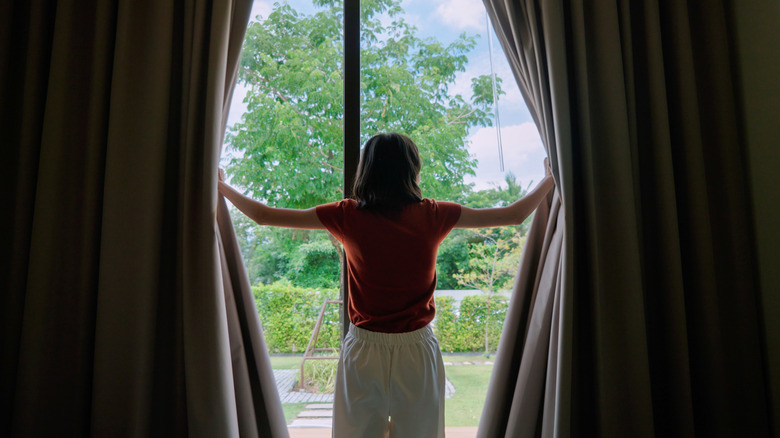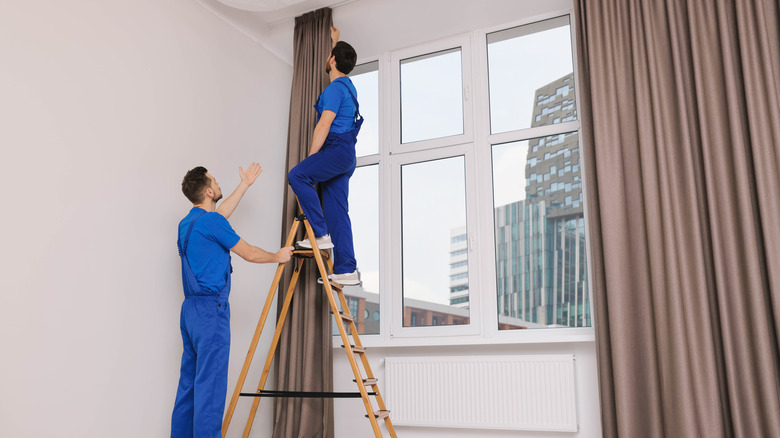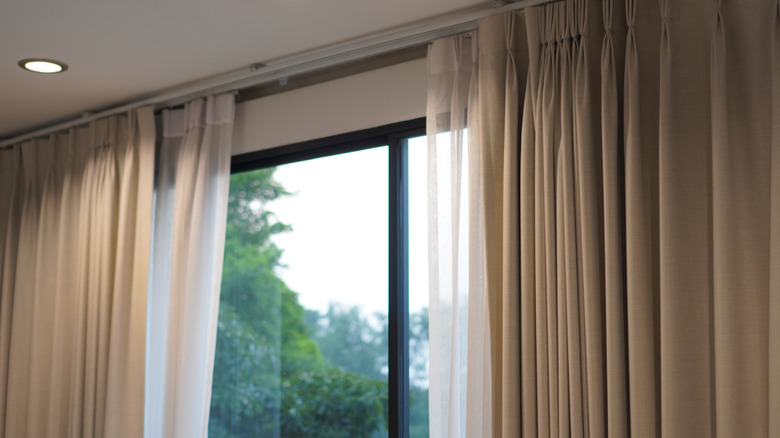Why Heavy Drapery Is One Of The Worst Choices For Your Living Room
Some bold and dramatic window coverings may be coming back in style, but that doesn't mean they are all right for your home. Before delving into the details, it's important to know that, technically speaking, there is a difference between drapes and curtains. Curtains tend to be more casual and made from lighter fabrics. Drapes, on the other hand, are typically heavy — both aesthetically and quite literally, since some even have small weights sewn into the corners to keep them from blowing in the breeze. They consist of lots and lots of fabric, and, in fact, a pair of drapes is typically at least twice as wide as the window they cover. All this volume makes a pretty noticeable design statement, so drapes are more likely to be found in formal spaces, like a living room.
While all that weighty fabric offers definite privacy and great insulating properties, drapes also come with some major downsides. For one, many designers think drapes are a once popular window treatment that dates your home. There's a visual heaviness to drapery that can make a room instantly feel stuffy or over-the-top formal. There's also a potential cost issue. Drapes are typically custom-fitted to your windows and are usually more expensive than off-the-rack window coverings.
The many downsides of heavy drapes
All those yards of thick fabric create an inviting home for spiders and other insects, who love to nestle themselves into the peaceful, dark folds. Dusting your drapes is one chore you need to do regularly to keep spiders away from your home, but that can be time consuming. All that heavy fabric isn't breathable, either, which makes it harder for air to circulate around a room. Condensation and moisture can become trapped between a window and the fabric, forming a lovely spot for mold to grow and spread.
Finally, all that heavy fabric is just difficult to hang. If drapes aren't hung wide enough, the excess fabric hangs over the glass, blocking some of the light trying to enter your room. Also, since drapes are often weighty, hanging them is almost certainly a two-person job. You need to be careful to check the specifications of the rod you are using and might even need to reinforce your walls for added security. It's a crucial step — if the rod and drapes come tumbling down, they could cause damage and even potentially injure small children or pets.
Drapery is often dark and dated
If you're big on natural light, drapery probably isn't right for your living room. All that heavy, thick fabric can make it hard to control the amount of light flowing into a room. That's because drapes don't have a lot of light-filtering options: They are either open, allowing light to enter a room, or closed, blocking light from a room. Drapery is often dramatic, traditionally using thick materials and dated patterns that can make living rooms look old-fashioned.
If you like the look of full drapes but want a little less weight, consider window coverings made from thinner or airier fabrics that allow light to filter into your home even when drawn shut. Fabrics like organic cotton or linen are airier and can have warm, natural textures. Also, try layering your drapery. Adding a sheer panel underneath can update the look with some softness and texture, and it will allow light to filter in through the window. Longer, statement-making drapes made with sheer or lightweight fabrics can create a dramatic effect without too much heaviness — this is a better option if you want window coverings that fall to the floor or even puddle onto it but don't want the heaviness of traditional drapes.


